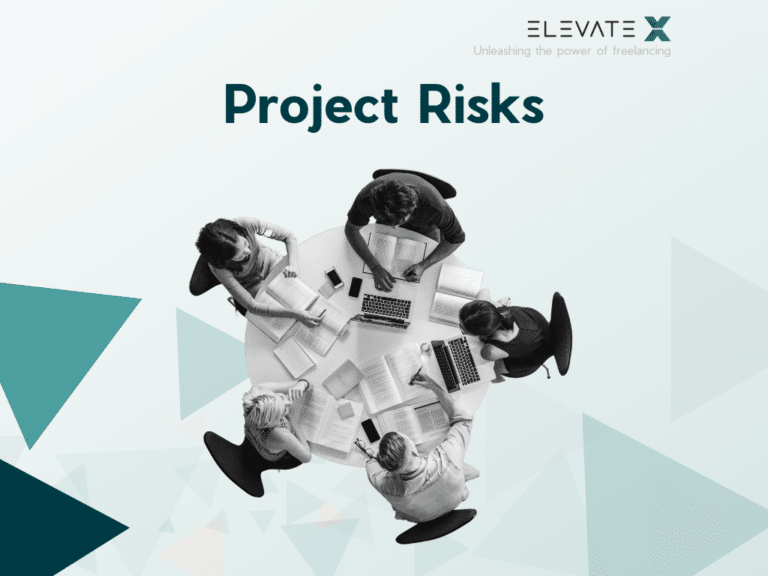It’s no surprise that projects come with various types of risks. What truly matters is the ability to identify these project risks in a timely manner and manage them effectively. In this blog article, you’ll learn how to recognize potential risks in projects, the common risks that occur, and how to minimize them through risk-oriented project management.
How Can I identify Project Risks In A Timely Manner?
Project risks are an unavoidable part of business life, but that doesn’t mean you’re helpless against them. Here, you’ll learn how to identify and address project risks early on.
Regular Audits
One of the most effective methods for early detection of project risks is conducting regular audits. This internal review should cover all aspects of the project: schedules, budgets, resources, and quality. Tools like Gantt charts or project management software can be very helpful in this regard.
Advantage: Provides a quick snapshot of the project’s status.
Frequency: Depending on the project, but at least once a month.
Stakeholder Feedback
Stakeholders, whether they are team members, customers, or suppliers, are often the first to identify potential risks. Regular meetings and feedback loops can provide valuable insights into potential risks.
Advantage: Direct feedback from people involved in the project.
Frequency: Ongoing throughout the project’s duration.
Expertise
Consulting with experts, whether internal or external, can provide further clarity. For example, if your project involves highly specialized technologies, external consultants can help identify risks in these areas early on.
Advantage: Expert opinions that enable objective risk assessment.
Frequency: As needed, especially for complex or technical projects.
Data Monitoring
Collecting and analyzing data can help identify patterns and trends that indicate potential risks. Key Performance Indicators (KPIs) should be monitored to determine if the project is progressing as planned.
Advantage: Enables data-driven decisions and predicts potential risks.
Frequency: Continuous, with regular check-ins.

KEY POINTS
- Project risks are an inevitable part of business life.
- Different types of risks can affect different areas of a project.
- In the age of digitization, risk management is becoming increasingly complex, but also more necessary.
- Without a well-thought-out concept for risk identification and assessment, even the best projects can fail.
What Project Risks Are There?
When it comes to project risks, it’s important to have a comprehensive picture. Different types of risks can impact different areas of a project. Here are the key categories of project risks to watch out for.
Schedule Risk
When a project is not completed as planned, it’s referred to as a schedule risk. This can happen for a variety of reasons, such as unexpected delays or a lack of resources.
- Example: A team member falls ill, causing a delay in project completion.
- How to manage: Use project management tools to monitor schedules and incorporate buffer times for unexpected delays.
Cost Risk
If a project exceeds its budget, it represents a cost risk. This can be caused by poor estimation of required resources or unexpected expenses.
- Example: The price of necessary software licenses suddenly increases.
- How to manage: Conduct a detailed cost analysis and plan for a financial buffer for unexpected expenses.
Resource Risk
This pertains to the availability and quality of resources required for the project. Whether it’s people, materials, or machinery, the absence or subpar quality of resources can significantly impact the project.
- Example: A required specialist is unavailable.
- How to manage: Ensure you have a backup team or alternative resources in place.
Quality Risk
A quality risk arises when the end result does not meet the established standards or expectations. This can be caused by a variety of factors, from team performance to the tools used.
- Example: The end result does not meet the required specifications.
- How to manage: Implement rigorous quality controls and reviews.
Technological Risk
Technology can be both a blessing and a curse. New technologies can lead to unforeseen problems, or the technology on which the project relies could become outdated.
- Example: A software update causes compatibility issues.
- How to manage: Keep software and hardware up to date and thoroughly test all technologies.
External Risks
Sometimes, risks lie outside of the project itself. Market fluctuations, political decisions, or natural disasters are examples of external risks.
- Example: A key supplier goes bankrupt.
- How to manage: Monitor the external environment and develop contingency plans.
Understanding these different types of project risks enables you to be better prepared and develop more effective risk management strategies. If you need assistance in this area, we can find the right project managerfor you.
Looking for a project manager?
Risk-Oriented Project Management: Methods And Techniques
In the age of digitization, risk management is becoming increasingly complex yet more necessary. Without a well-thought-out concept for risk identification and assessment, even the best projects can fail. In this section, you will learn how to identify, assess, and control project risks using various methods and techniques. This is the core of risk-oriented project management.
Risk Analysis: Identifying And Evaluating Potential Risks
Here are some proven methods:
SWOT Analysis: This method requires an in-depth analysis of the project’s Strengths, Weaknesses, Opportunities, and Threats.
Pro Tip: Use this method during the planning phase for a comprehensive understanding of the project.
Pareto Analysis: Helps focus on the most significant risks. The rule states that 20% of the risks cause 80% of the problems.
Pro Tip: Identify the critical risks and allocate your resources accordingly for maximum benefit.
Monte Carlo Simulation: A computer-based technique that plays out various scenarios to determine a range of possible outcomes and the probabilities of their occurrence.
Pro Tip: Particularly helpful in complex projects with many variable elements.
Risk Assessment: Assigning Priorities To Each Identified Risk
Once the risks are identified, they need to be assessed using different techniques:
Risk Matrix: A useful tool that evaluates risks based on their likelihood and severity of impact.
Pro Tip: Use this matrix to quickly decide which risks require immediate attention.
Critical Path: This method identifies the sequence of phases, tasks, or activities that determine a project’s timeline.
Pro Tip: Use this method to identify tasks that pose a high risk if completed late.
Risk Control Plans: Developing Risk Mitigation Measures
After risk assessment, it’s time to develop measures for risk mitigation. This is the proactive part of risk management.
Risk Mitigation Strategies: These can range from implementing redundant systems to outsourcing or securing insurance policies.
Pro Tip: Consider various options and choose the one that offers the best protection at the lowest cost.
Risk Response Plans: These plans include specific steps to address each identified risk, from risk avoidance to risk reduction or transfer.
Pro Tip: Keep the plan flexible as circumstances may change, and the plan must be adaptable.
Continuous Monitoring: Ongoing monitoring of the risk situation is essential to ensure that the risk control plan is effective and can be adjusted as needed.
Pro Tip: Establish Key Performance Indicators (KPIs) for risk management and review them regularly.
The “best” method depends on various factors, including the complexity of the project, available resources, and the specific risks it entails. For less complex projects, a SWOT analysis or Pareto analysis may be sufficient. For more complex projects, advanced techniques like Monte Carlo simulation could be useful.
Effective risk management is an ongoing process. It’s good practice to review and adjust the plan at regular intervals, especially when there are changes in project scope, team, or external factors. Many experts recommend reviewing the plan at least once per quarter.
Absolutely! A limited budget should not be a barrier to effective risk management. Many of the methods described above require more time than money. Tools like a simple risk matrix or SWOT analysis can be conducted with minimal financial expenditure.








